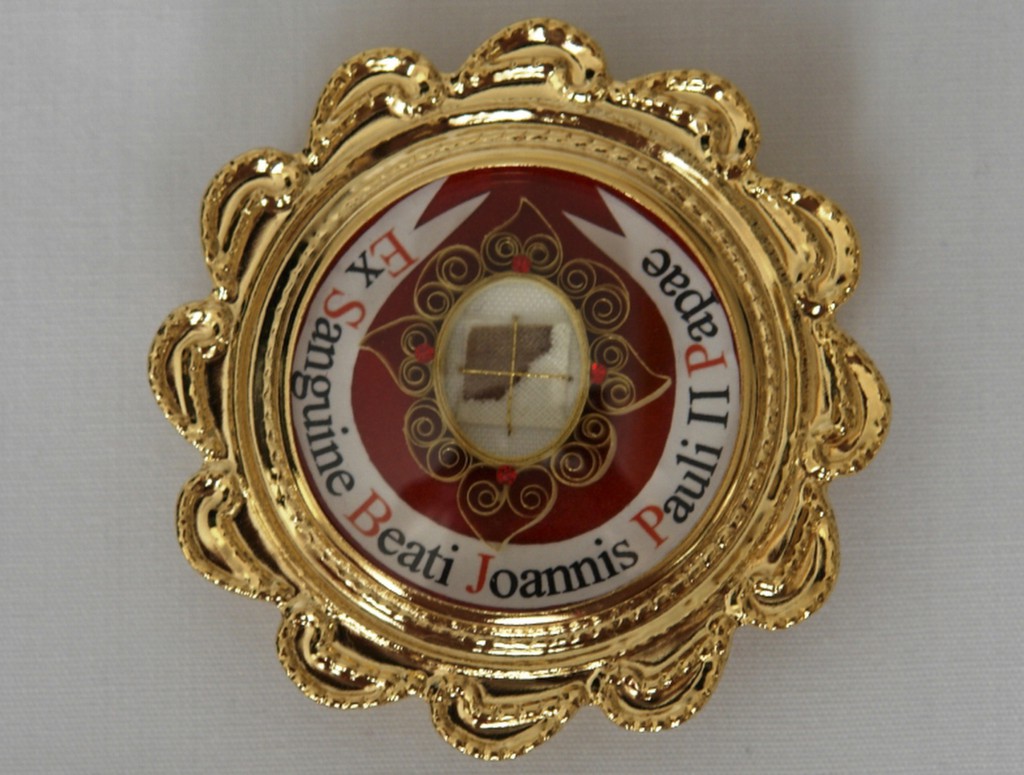
By Navar Watson
Of the 1,752 canons that make up the “Code of Canon Law,” just one refers to the sale of sacred relics.
Canon 1190 Paragraph 1 says “it is absolutely forbidden to sell sacred relics.” But there’s kind of a gray area with regard to the offer of a relic in exchange for a donation.
For All the Saints, a Catholic ministry based in El Paso, Texas, that loans holy relics to local parishes for special occasions, explains how the church classifies relics.
First-class relics are typically body parts of saints, such as a bone; or in the case of Blessed John Paul II, a vial of blood. Second-class relics include clothing, books, rosaries or anything directly related to or used by the saint during his or her life. Third-class relics are items someone has touched to a first- or second-class relic.
For All the Saints allows the use of its some 170 relics free of charge and says the local churches that display them relics should never charge for people to see them.
“Sponsoring churches and organizations are never to charge an admission fee or even provide for a free will offering or donation to view the veneration as this could be construed by some as paying for a spiritual favor (simony), which is (forbidden) by canon law,” according to the website.
Its collection includes a first-class relic of St. Kateri Tekakwitha, which St. Raphael Church in El Paso borrowed in October 2012 for a celebration of her canonization.
Mary’s Way Worldwide Apostolate Inc., in Brick, N.J., offers a limited supply of second-class relics, such as fragments of religious habits worn by Sts. Padre Pio and Therese of Liseux, to the public in its online store. Each fragment is encased in a reliquary; on the other side is a photo of the saint.
Francis Slinsky, founder and director of Mary’s Way, told Catholic News Service he obtained the relics from his spiritual director in Italy, Father David. He doesn’t use a last name. A habit worn by Padre Pio was given to Father David’s uncle, Slinsky explained, and a group of Carmelites gave Father David a habit worn by St. Therese.
Slinsky, too, noted that canon law forbids the selling of first-class relics. Mary’s Way has a supply of first-class relics obtained from a Vatican source, but they are strictly not for sale, he said.
The second-class relics on Mary’s Way’s site are available for a donation of $250. The money goes mainly to help feed and clothe orphans, according to Slinsky.
On whether or not donations equal sales, canon law is silent.
“That’s what we call, in canonical terms, the ‘gray area,'” said Deacon P. Stephan Phelps from the Midwest Canon Law Society.
Deacon Phelps, who serves in the Archdiocese of Louisville, Ky., believes mandatory donations constitute as sales because there is no way for one to receive the relic without paying money first.
“If it looks like a duck and sounds like a duck, it’s a duck,” Deacon Phelps said.
Canon lawyer J. Michael Ritty said, “If you’re charging a specific donation for it, you’re really selling it. You’re splitting some hairs there. You’re getting into issues of what is right or wrong.”
Whether or not donations for relics is acceptable is a question for moral theologians, he said.
Slinsky said all of the donation money goes directly to Father David, who runs an orphanage in Italy.
“Part of the issue is, what are the relics — first, second or third — going to be used for?” said Father Robert Kaslyn, dean of the School of Canon Law at The Catholic University of America in Washington. “There are legitimate uses for relics. There are legitimate places for them in a church.”
“Even though the seller requests a donation and is not selling them, there’s no control over who makes the required donation and obtains the relics nor the purpose for which the relics would be used,” he said in an email to CNS.
Slinsky doesn’t consider what his site does as “selling” relics, adding, “You’ve got to watch out” when relics are listed for sale on eBay or other sites.
“There are a lot of dog bones and cat bones, and they’re coming out of Florida. … There are millions of them,” he told CNS. “It’s a multimillion dollar industry where they put these alleged first-class relics … on the Internet, and they’re phony. They’re all phony.”
EBay forbids listing for sale “the human body, or any human body parts or products.” The official policy, posted on the website, has two exceptions: Sellers can list items containing human scalp hair, such as that in a locket, and skulls and skeletons of non-Native Americans that are intended for medical use.
In a 2011 interview with CNS, Elizabeth Lev, an art historian and author in Rome, explained people’s fascination with relics.
“It feels like you’ve got almost like a hotline into heaven,” she said. A relic is “something we can see and touch, and it becomes our portal to a world we cannot see and cannot touch.”
Though authentic relics are sacred, they cannot be used to help grant one’s wishes.
“A relic is not a binding dogmatic contract: ‘Here is the blood of John Paul II, you may pray before it and your prayers will be answered.’ It doesn’t work like that. It’s not magic,” Lev said.
“I think the broader picture here is helpful,” Father Kaslyn said. “It’s not just the idea of selling relics or requesting a donation for them. It’s the broader context of respect for the human body (and) our fundamental Christian belief in the resurrection of the dead that prevents especially the selling of any relics or transferring ownership through a donation.” – CNS